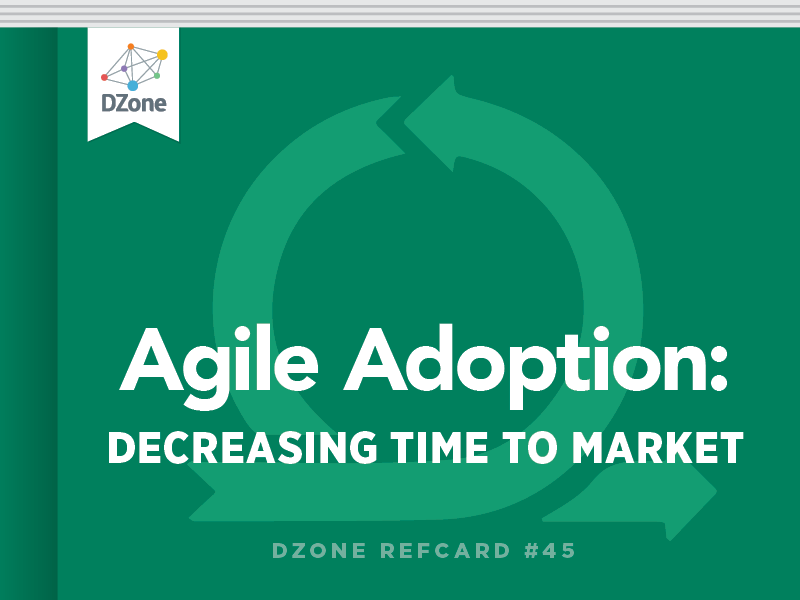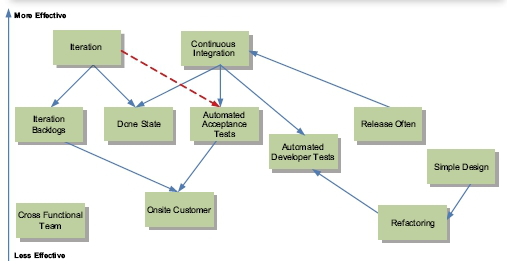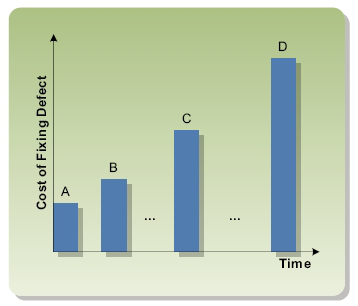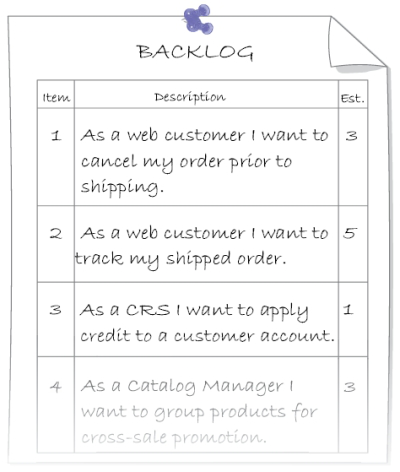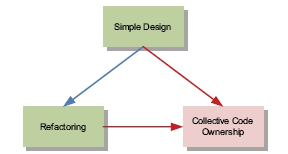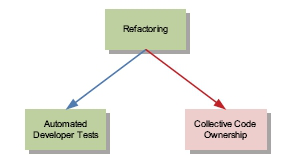To successfully adopt Agile practices let’s start by answering the question “which ones first?” Once we have a general idea of how to choose the first practices there are other considerations.
Become “Well-Oiled” First
One way to look at software development is to see it as problem solving for business. When considering a problem to solve there are two fundamental actions that must be taken:
- Solving the right problem. This is IT/Business alignment.
- Solving the problem right. This is technical expertise.
Intuitively it would seem that we must focus on solving the right problem first because, no matter how well we execute our solution to the problem, if it is the wrong problem then our solution is worthless. This, unfortunately, is the wrong way to go. Research shows in Figure 3, that focusing on alignment first is actually more costly and less effective than doing nothing. It also shows that being “well-oiled”, that is focusing on technical ability first, is much more effective and a good stepping-stone to reaching the state where both issues are addressed.
This is supported anecdotally by increasing reports of failed Agile projects that do not deliver on promised results. They adopt many of the soft practices such as Iteration, but steer away from the technically difficult practices such as Automated Developer Tests, Refactoring, and Done State. They never reach the “well-oiled” state.
So the lesson here is make sure that on your journey to adopt Agile practices that improve time to market (or any other business value for that matter), your team will need to become “well-oiled” to see significant, sustained improvement. And that means you should plan on adopting the difficult technical practices for sustainability.
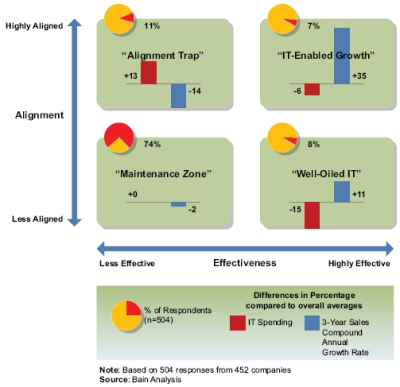
Figure 3-The Alignment Trap (from Avoiding the Alignment Trap in Information Technology, Shpilberg, D. et al, MIT Sloan Management Review, Fall 2007.)
Minimize What You Build
Statistics show that most of what software development teams build is not used. In Figure 4 we see that only 7% of functionality is always used. And 45% is never used. This is a sad state of affairs, and an excellent opportunity. One of the easiest ways to speed up is to do less. If you have less to build, then not only do you spend less time writing and testing software, but you also reduce the complexity of the entire application. And by reducing the complexity of the application it takes less time to maintain because you have a simpler design, fewer dependencies, and fewer physical lines of code that your developers must understand and maintain.
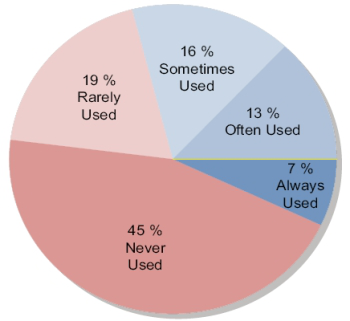
Figure 4- Most functionality built is not used
Cross-Functional Team
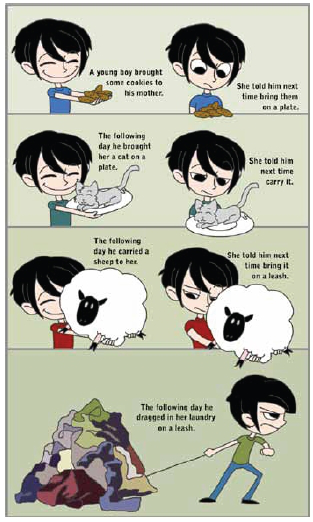
Figure 5-Context matters. Choose Agile practices that fit your context.
The practices are all described within context. So, for example,the context for the Release Often practice indicates that your customers should be willing to install and run frequent releases and that the quality of your current builds are exceptional. If this is not the case, if your current releases go through a ‘stabilization phase’ and your customers have learned never to take a 1.0 release, then do not adopt Release Often, you will end up hurting your relationship with your customers.
Learning is the Bottleneck
Here is a hypothetical situation that we have presented to many experienced software development teams:
Suppose I was your client and I asked you and your team to build a software system for me. Your team proceeds to build the software system. It takes you a full year – 12 months – to deliver working, tested software.
I then thank the team and take the software and throw it out. I then ask you and your team to rebuild the system. You have the same team. The same requirements. The same tools and software. Basically – nothing has changed – it is exactly the same environment.
How long will it take you and your team to rebuild the system again?
When we present this hypothetical situation to development practitioners – many of them with 20+ years experience in building software – they typically respond with anywhere between 20% to 70% of the time. That is, rebuilding a system that originally takes one year to build takes only 2.5 to 8.5 months to build. It is a huge difference!
So, what is the problem? What was different? The team has learned. They learned about each other as a team and have gelled over the year. They learned about the true requirements – not just those written down. They also learned to use the toolset, they experienced the idiosyncrasies that come up during all software development, and basically they worked through all the unknowns until they built and delivered a successful software solution. Learning is THE bottleneck of software engineering.
The learning that occurs makes up a significant percentage of the time spent on the work. That’s the main reason that Agile practices work so well – they are all about recognizing and responding to change. Agile practices, from continuous integration to iterations, all consist of cycles that help the team learn fast. By cycling in every possible practice, Agile teams accelerate learning, addressing the bottleneck of software engineering. Call it “scientific method,” “continuous improvement” or “inspect and adapt”, to truly benefit from these practices you and your team(s) must learn well and learn often.
Know What You Don’t Know
Since learning is the bottleneck, it makes sense to talk a bit about how we actually learn. The Dreyfus Model of Skill Acquisition, is a useful model of learning. It is not the only model of learning, but it is consistent, has been effective, and works well for our purposes. This model states that there are levels that one goes through as they learn a skill and that your level for different skills can and will be different. Depending on the level you are at, you have different needs and abilities. An understanding of this model is not crucial to learning a skill; after all, we’ve been learning long before this model existed. However, being aware of this model can help us and our team(s) learn effectively.
So let’s take a closer look at the different skill levels in the Dreyfus Model:
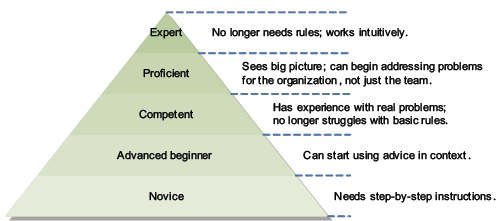
Figure 6-The Drefyus Model for skill acquisition. One starts as a novice and through experience and learning advances towards expertise.
How can the Dreyfus Model help in an organization that is adopting agile methods? First, we must realize that this model is per skill, so we are not competent in everything. Secondly, if agile is new to us, which it probably is, then we are novices or advanced beginners; we need to search for rules and not break them until we have enough experience under our belts. Moreover, since everything really does depend on context,and we are not qualified to deal with context as novices and advanced beginners, we had better get access to some people who are experts or at least proficient to help guide us in choosing the right agile practices for our particular context. Finally, we’d better find it in ourselves to be humble and know what we don’t know to keep from derailing the possible benefits of this new method. And we need to be patient with ourselves and with our colleagues. Learning new skills will take time, and that is OK.
Choosing a Practice to Adopt
Choosing a practice comes down to finding the highest value practice that will fit into your context. Figure 1 will guide you in determining which practices are most effective in decreasing your time to market and will also give you an understanding of the dependencies. The other parts in this section discuss other ideas that can help you refine your choices. Armed with this information:
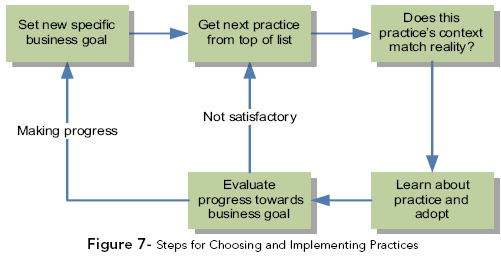
Figure 7-Steps for Choosing and Implementing Practices
Small steps and failing fast are the most effective methods to release quickly. Weed out defects early because the earlier you find them, the less they will cost to fix as shown in Figure 2 and you won’t be building on a crumbling foundation. This is why Continuous Integration and Iteration lead the practices that most positively affect time to market. They are both, however, dependent on several practices to be effective, so consider starting with Automated Developer Tests and the Iteration trio – Iteration, Iteration Backlog, and Done State.
Next Steps
This refcard is a quick introduction to Agile practices that can help you improve your time to market and an introduction of how you to choose the practices for your organizational context. It is only a starting point. If you choose to embark on an Agile adoption initiative, your next step is to educate yourself and get as much help as you can afford. Books and user groups are a beginning. If you can, find an expert to join your team(s). Remember, if you are new to Agile, then you are a novice or advanced beginner and are not capable of making an informed decision about tailoring practices to your context.

